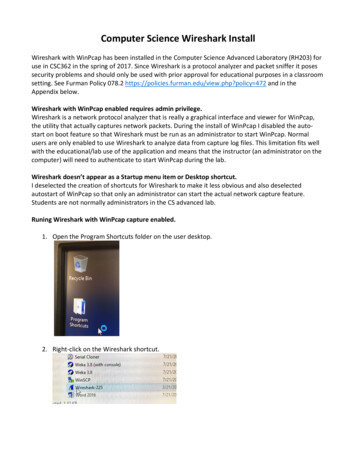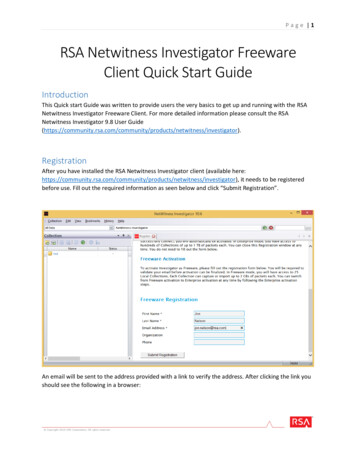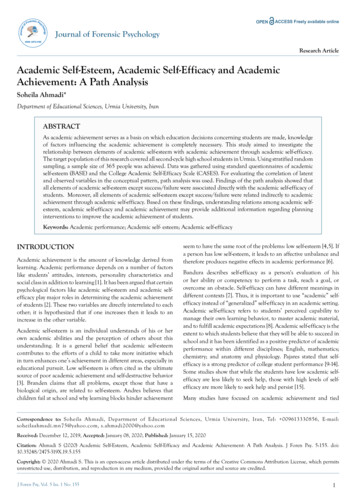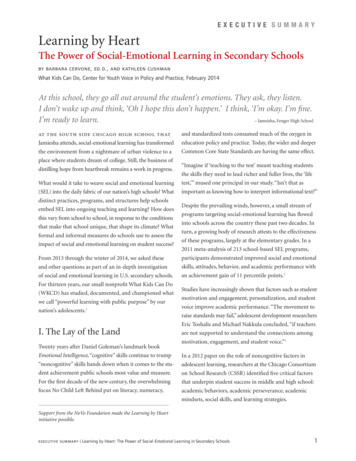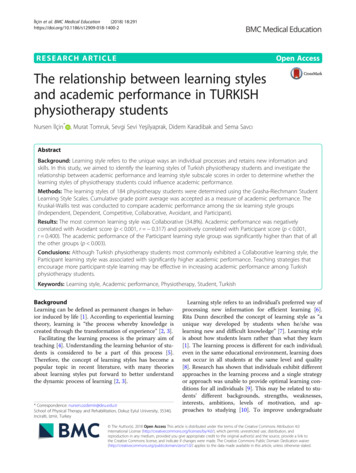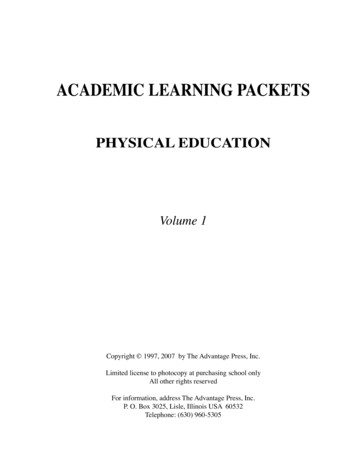
Transcription
ACADEMIC LEARNING PACKETSPHYSICAL EDUCATIONVolume 1Copyright 1997, 2007 by The Advantage Press, Inc.Limited license to photocopy at purchasing school onlyAll other rights reservedFor information, address The Advantage Press, Inc.P. O. Box 3025, Lisle, Illinois USA 60532Telephone: (630) 960-5305
TABLE OF CONTENTSACADEMIC LEARNING PACKETSPHYSICAL EDUCATIONINSTRUCTIONS AND SUGGESTIONSLearning Packet #1: VOLLEYBALLStudent Response PacketLearning Packet #2: BADMINTONStudent Response PacketLearning Packet #3: TENNISStudent Response PacketLearning Packet #4: BASKETBALLStudent Response PacketLearning Packet #5: BOWLINGStudent Response PacketLearning Packet #6: SOCCERStudent Response PacketLearning Packet #7: ARCHERYStudent Response PacketPhysical Education Learning Packets 2007 The Advantage Press, Inc.
Learning Packet #8: WRESTLINGStudent Response PacketLearning Packet #9: GOLFStudent Response PacketLearning Packet #10: FIELD HOCKEYStudent Response PacketLearning Packet #11: BASEBALLStudent Response PacketPhysical Education Learning Packets 2007 The Advantage Press, Inc.
LICENSE TERMSFORADVANTAGE PRESS LEARNING PACKETSThe following License Terms govern your use of the Advantage Press, Inc. Learning Packets.1.License Grant.The Advantage Press, Inc. grants you a license to use the LearningPacket Files contained on the enclosed CD. “Use” includes using, storing, loading, installing, executing, and displaying the Learning Packet Files. You may modify the Learning Packet Files.2.Ownership.The Learning Packet Files are owned and copyrighted by The Advantage Press, Inc. Your license confers no title to, or ownership in, the Learning Packet Files and is nota sale of any rights in the Learning Packet Files.3. Copies and Adaptations. You may only make copies or adaptations of the Learning Packet Filesfor archival purposes and for dissemination in the Purchasing School Building. You must reproduceall copyright notices in the original Learning Packet Files and on all copies or adaptations. You maynot copy the Learning Packet Files onto any public network.4.General Use.You may install and use a copy of the Learning Packet Files on yourschool’s computer(s) including network server and portable computing devices by adhering to theprovisions in numbers five and six below.5.Server Use.You may install and use a copy of the Learning Packet Files on yourInternal computer Network for use on computers within the physical purchasing site. No othernetwork use is permitted, including, but not limited to using the Learning Packet Files either directlyor through commands, data or instructions from or to a Computer not part of your internal network,for internet or web hosting services or by any user not licensed to use this copy of the LearningPacket Files through a valid license from The Advantage Press.6.Computer Use.The primary user of the Computer on which the Learning Packet Filesare stored may also make a second copy for his or her exclusive use on a portable Computer provided the Learning Packet Files are not being disseminated onto a computer network outside of thepurchasing site.7.Termination.The Advantage Press, Inc. may terminate your license, upon notice, forfailure to comply with any of the above terms. Upon termination, you must immediately destroy theLearning Packet Files, together with all copies, adaptations and merged portions in any form.Physical Education Learning Packets 2007 The Advantage Press, Inc.
PHYSICAL EDUCATION PACKET SYSTEMINSTRUCTIONS AND SUGGESTIONSPhysical Education Learning Packets provide constructive learning experiences forstudents who do not, or cannot, meet physical education requirements. This volumecontains 11 Learning Packets, ranging from volleyball to baseball.The purpose of these Learning Packets is to acquaint students with particular sports orother physical activities. There should be a sufficient variety among these packets tointerest almost any student, whether or not he or she is particularly active in sports.In some cases, you may want to distribute these packets to students who, for physicalor health reasons, cannot participate in sports and other strenuous activities, but whowould like to know how games are played and scores are kept so that they can feelmore a part of these school activities, and be a more informed spectator. PhysicalEducation Learning packets will give these students the rudiments of each sport oractivity.You may also have students who have no apparent interest in physical education, andhabitually present a variety of excuses not to participate (such as “forgetting” to bringtheir gym shoes or clothes to class, etc.). These packets can be used as a means ofdiscouraging such students from making excuses for not participating.There may also be students who would like to know more about different sports andwould welcome an opportunity to read about the history and techniques of a particularsport in addition to being a player. In this case, the packets may be used to provideextra credit for such inspired students.Physical Education Packets also provide instant lesson plans for any substitute teacher.All that is necessary is access to a photocopier. As many copies of a packet as neededcan be made. PE teachers can also use Physical Education Packets to introduce a sportor activity to a class. In addition, you may want to use the packets as a unit lesson, andutilize the questions and puzzles for a unit test.Physical Education Learning Packets 2007 The Advantage Press, Inc.
Each packet consists of 4 or 5 pages of narrative material for each sport or physicalactivity, including an introduction, history, description of how the game is played, andindividual techniques for playing.After the student has read the narrative, there are 10 questions, a crossword puzzle,and a wordsearch to evaluate student mastery of the materials.INSTRUCTIONS FOR USING THE PACKETS1.Make extra copies of your Learning Packets. Don’t give students the mastercopies. Save them for making additional copies.2.Give each student one of the packets for him or her to read. Also give him orher the corresponding questions, crossword puzzle and wordsearch puzzle. Eachpacket is designed to be a 45-minute lesson.3.A teacher answer section is provided with each packet for ease of grading.Graded Physical Education Packets can give you an objective assessment toolfor arriving at quarter or semester grades.Physical Education Learning Packets 2007 The Advantage Press, Inc.
VOLLEYBALLPACKET # 1INSTRUCTIONSThis Learning Packet has two parts: (1) text to read and (2) questions to answer.The text describes a particular sport or physical activity, and relates its history, rules,playing techniques, scoring, notes and news.The Response Forms (questions and puzzles) check your understanding and appreciation of the sport or physical activity.INTRODUCTIONVolleyball is a popular sport which can be playedboth indoors and outdoors. It appeals to people ofall ages and skill levels. It is fast-paced, with constant jumping and running, and thus provides astrenuous aerobic workout. It also requires mental alertness and quick, precise physical reactions.Many associate volleyball with the beaches ofsouthern California and in fact, a number of professional players get their start by playing beachvolleyball. However, volleyball is popular not onlyon the beaches, but in virtually every country ofthe world. In 1964, it was officially recognized aspart of the Olympic Games.HISTORY OF THE GAMEVolleyball originated in Massachusetts in 1895 when the director of a local YMCA usedthe bladder of a basketball for a ball and a tennis net as the first volleyball net. The gamewas regulated by the YMCA until 1928 when the United States Volleyball Associationwas founded.Physical Education Learning Packets#1 VolleyballText 2007 The Advantage Press, Inc.
HOW VOLLEYBALL IS PLAYEDThe name “volleyball” is not an entirely accurate description of this sport. The object ofthe game is hit the ball over the net in such a way that the opposing team cannot return it.Volleyball is played on a court 30 feet wide by 60 feet long. The net is three feet high andspans the width of the playing area. The top of the net is positioned eight feet (in men'svolleyball) from the floor or playing surface. The modern volleyball is about the size ofa soccer ball.The game is played by two opposing teams, withsix players on each team. Once the ball is putinto play, it is “volleyed” back and forth betweenthe teammates up to three times before it is hitover the net or until it falls to the floor, is hit outof bounds or a team commits a foul. The sameplayer may not make a hit twice in a row. Even ifthe ball hits a player by accident, it counts as oneof the three touches allowed per side. However,if a player blocks a spike, the block is not considered a “hit.”VOLLEYBALL SCORING SYSTEMSRALLY POINT SCORINGThe team winning a rally scores a point. When the receiving teamwins a rally, it gains a point and the right to serve, and its playersrotate one position clockwise. The best of three or best of five gameswill win matches. Each non-deciding game will be won by the teamthat first scores 25 points with a minimum two-point advantage. Ifthere is a deciding game, it will be won by the team that first scores15 points with a minimum two-point advantage.SIDEOUT SCORINGOnly the serving team may score a point, except in the deciding gamewhen rally-point scoring is used. When the receiving team wins arally, it gains the right to serve (also scoring a point in the decidinggame), and its players rotate one position clockwise. Rotation ensures that players play at both the net and the back zone of the court.A team wins a game by scoring 15 points with a two-point advantagePhysical Education Learning Packets#1 VolleyballText 2007 The Advantage Press, Inc.
and wins the match by winning the best of three or five games. In the event of a 16-16tie, the team scoring the 17th point wins a non-deciding game with only a one-pointadvantage. In a deciding game there is no point cap.Almost all schools have changed from “Sideout Scoring” to “Rally Point Scoring.” Rallyscoring looks very similar to a side-out game, with the main difference being a pointscored every time the ball is blown dead.What constitutes a match when you rally score? Teamswill play the best three out of five games. “Game-point”for the first four games will be 25 points. (You mustwin by two points.) The fifth and deciding game isplayed to 15. (Again, you must win by 2 points.)How much time should be allotted for matches that arerally scored? Most three of five rally matches end inthree games. The approximate length of time for a game(not including warm-up) is less than 20 minutes. Threegame matches take approximately 60 minutes, whilefive-game matches take approximately 90 minutes. Thenature of volleyball allows games to be substantiallyshorter when one team is strong and another weak.Rally scoring no longer accommodates long non scoring periods during a game or match.What is the “let serve?” The “let serve” is a ball that whenserved, hits the net without touching the net antenna and continues across the net into the opponent’s court. The let serve isa playable live ball. The let serve is a strategy used to keep thegame moving with fewer interruptions in play.With the “let serve”, there is no longer a need to touch the netwhen giving the signal to serve.Time-outs: Each team is allowed a maximum of two time-outsper game. A time-out is a maximum of 60 seconds, althoughplay may resume sooner if both teams are ready prior to 60seconds. Extra time-outs are not granted during rally scoring,nor are time-out accumulative during a match.Physical Education Learning Packets#1 VolleyballText 2007 The Advantage Press, Inc.
The game has a total of 15 points. If a team fails to serve properly, return the ball, or commits any other fault, the opponentwins the rally and scores the point. Each game must be won bya two-point margin. A match consists of either three or five 15point games. The team which wins two (in a three-game match)or three (in a five-game match) games is the winner of thematch.Volleyball requires a referee, who generally has the final wordregarding points in dispute, an umpire who assists the referee,a scorekeeper, a timekeeper and linesmen. Even though theremay be officials present during a game, players who commitfouls are expected to call out their own mistakes.SKILLS AND TECHNIQUESTHE READY POSITION AND JUMPOne of the basic positions in volleyball is called the “ready position.” The knees areslightly bent with hands at waist level and elbows near the body to allow the player toconcentrate on the ball. Players should learn this position so that time is not wastedwhen the ball is hit. Jumping is always done near the net. Players should practice jumping so that they do not touch the net, or bump into or injure other players. They shouldalso remember always to jump parallel to the net.THE SERVE: OVERHAND AND UNDERHANDServing is a crucial skill for the volleyball player to learn. The cardinal rules of servingare simple: do not step on a boundary line, and get the ball over the net.The overhand serve is the most popular and effective serve. It is similar to a tennisserve. The ball is thrown into the air so that it rises a few feet above the server’s head. Asthe ball comes down, the right arm (if you are right-handed) is raised up and back whilethe elbow comes forward. The arm is then extended at the elbow and the server hits theball with the heel of the hand.The underhand serve is a good serve for beginners to use. It is simply another way ofgetting the ball over the net. The ball is held in one hand and hit by the heel of the otherhand. The underhand serve is generally not as effective as the overhand serve.Physical Education Learning Packets#1 VolleyballText 2007 The Advantage Press, Inc.
THE PASS OR SETThe pass is a difficult move for many beginning players. Thisskill looks easier than it actually is when performed. Oncethe ball is served, the player who will pass the ball gets intoposition under the ball with knees bent, hands up and fingerscupped. All the fingers and the two thumbs contact the ball,but the ball does not touch the palm of the hand.When the ball is in the air over the serving side’s court, itmay be passed up to three times before it is returned over thenet. One player cannot pass the ball twice in a row.Note that overhead passes are not used when the returning ball is a “spike.”THE SPIKEThe spike is one of the most difficult plays in volleyball: a player has to run, jump and hit the ballto a specific spot on the other side of the net. However, it is the best offensive move in volleyball,and it should be learned.Generally, a spiked ball is hit with an open hand.However, unless a player is quite experienced,spiking a ball can sometimes result in the ball going out of bounds or into the net. Remember thatpractice in timing, jumping and hitting are requiredto spike correctly. A spiked ball, hit properly, canmove up to a hundred miles an hour.THE FOREARM BOUNCE PASS-BUMPThe bump is used for receiving serves and spike balls. This shot is easy to executebecause the ball simply bounces or bumps off the clasped hands, wrists or forearms.The purpose of this shot is to bounce the ball into the air so that a teammate can getunder it to make a set-up (a move usually used to direct the ball to the spiker).Physical Education Learning Packets#1 VolleyballText 2007 The Advantage Press, Inc.
ONE-HAND BOUNCE PASS-DIGThis is a recovery shot, and is used if the ball received is low and off to the side of aplayer. If you cannot make a bump pass, use a dig or save pass instead. In this move, thehands are cupped. They are then placed under the ball just before it hits the floor.THE BLOCKThis move is used chiefly as a defensive position to stop spiked balls. As with spiking,timing is important in blocking.A player must anticipate an opponent's spike andposition him or herself accordingly. The blocker thenjumps just after the spiker has jumped. The blocker’sarms should be extended upward with fingers spreadwide apart. This allows the ball to bounce off theheels of the blocker’s hands and land on the oppositeside of the net.This is the only move in volleyball that allows the player’s hands to goover the top of the net.EQUIPMENT AND CLOTHINGStandard clothing for playing volleyball is comfortable sportswear which allows for freemovement. Gym shoes are a must since most gyms do not allow anyone on the floor inregular shoes. When played on the beach, attire ranges from gym clothes to swimsuits.Many play barefoot in the sand.VOLLEYBALL NOTES AND NEWSUCLA swept Penn State in three games to win the 2006 National Collegiate Men’s Volleyball Championship, defeating the Nittany Lions 30-27,30-27,30-27. It is the 19th timethe Bruins have won the national title in men’s volleyball. The Anteaters posted 18 morewins than last year as they entered the NCAA Tournament with a 27-4 record and a No.1ranking in the CSTV/AVCA Division I-II Men’s Coaches poll.Physical Education Learning Packets#1 VolleyballText 2007 The Advantage Press, Inc.
In 2006 Division I women’s volleyball, the No. 16 University of Hawai‘i Rainbow Wahinevolleyball team (15-5) defeated the Notre Dame Fighting Irish (12-7) 30-28, 30-25, 2230 and 30-23 in front of a crowd of 6,027 at the Stan Sheriff Center, ending their stretchof seven matches in 11 days.Volleyball is also an Olympic sport. At the 2004 Olympics, both women and men had 12teams in competition.Medalists in the 2004 Athens Olympic Indoor and Beach Volleyball competition arelisted on the next page.Indoor Competition:Men’s:GOLD - BRAZILSILVER - ITALYBRONZE - RUSSIAWomen’s:GOLD - CHINASILVER - RUSSIABRONZE - CUBABeach Competition:Men’s:GOLD - BRAZILSILVER - SPAINBRONZE - SWITZERLANDWomen’s:GOLD - UNITED STATESSILVER - BRAZILBRONZE - UNITED STATESIn addition to these national and international contests, local volleyball competitions areheld in most states. Check your local schools and volleyball associations for coverage.You can also find out more by visiting these volleyball web sites on the //www.volleyball.orgPhysical Education Learning Packets#1 VolleyballText 2007 The Advantage Press, Inc.
STUDENT RESPONSE PACKETVOLLEYBALLNAMEDATEWHAT TO DOThe following questions will help you to have a greater appreciation and understandingof volleyball. Write your answers in the spaces below the questions. If there is not enoughroom, write on the backs of these sheets. Be neat, spell correctly, and write in completesentences.1.Why is volleyball considered to be such a good aerobic exercise?2.How many total points can be scored in a game of volleyball?3.What does “a match” in volleyball consist of?4.What clothing is typically worn for playing volleyball?Physical Education Learning Packets#1 VolleyballText 2007 The Advantage Press, Inc.
5.What is “the ready position” in volleyball and how is it used?6.What is an overhand serve?7.What is an underhand serve?8.What is a pass and how is it used?9.How is a spike ball hit?10.How is a block used?Physical Education Learning Packets#1 VolleyballText 2007 The Advantage Press, Inc.
123456789101112131415161718Physical Education 1 CrosswordName: Date:19Across:1. The number of players on a volleyballteam3. A type of forearm pass5. The ball is put into play when one teamdoes this8. To serve with the heel of the hand9. This person assists the referee11. It is three feet high and is located in thecenter of the court12. The top of the net is feet from thefloor13. Most number of times the ball can bevolleyed across the net15. First volleyball was made of this from abasketball17. They assist the referee19. Three out of five15-point gamesPhysical Education Learning Packets#1 VolleyballDown:1. Fast offensive hit to a specificspot2. Total points in a game4. Most popular serve technique6. The forearm bounce pass7. It is 30 feet wide and 60 feetlong10. Chief official for a volleyballgame14. The palm does not touch the ballduring a16. Defensive technique to stopspiked balls18. Institution where volleyball wasfoundedText 2007 The Advantage Press, Inc.
Physical Education 1 Word SearchName: Date:Use the clues below to discover words in the above puzzle. Circle the .19.20.It is 30 feet wide and 60 feet longIt is three feet high and is located in the center of the courtDefensive technique to stop spiked ballsThree out of five 15-point gamesMost popular serve techniqueTotal points in a gameThe ball is put into play when one team does thisInstitution where volleyball was foundedThe top of the net is feet from the floorFast offensive hit to a specific spotA type of forearm passThey assist the refereeChief official for a volleyball gameFirst volleyball was a basketball'sMost number of times the ball can be volleyed across the netTo serve with the heel of the handThe number of players on a volleyball teamThe palm does not touch the ball during aThe forearm bounce pass-This person assists the refereePhysical Education Learning Packets#1 VolleyballText 2007 The Advantage Press, Inc.
BADMINTONPACKET # 2INSTRUCTIONSThis Learning Packet has two parts: (1) text to read and (2) questions to answer.The text describes a particular sport or physical activity, and relates its history, rules,playing techniques, scoring, notes and news.The Response Forms (questions and puzzles) check your understanding and appreciation of the sport or physical activity.INTRODUCTIONBadminton is a popular and physicallydemanding game with an interestinghistory. Like most sports, it requires thatplayers be physically fit and alert. Thegame demands intense playing time onthe court—in fact, games can last anywhere from thirty to ninety minutes.Badminton is considered a good sportto help build and maintain overall fitness.During an average game, players jump, run,turn and twist in many different directions. Infact, a top-level amateur badminton player runsmore in a badminton game than a football end does during a one-hour football game. Abadminton player also uses his/her arms more than a pitcher does in the average one andone-half hour baseball game! In short, badminton is great aerobic exercise. It’s a funsport and also is a means to better physical fitness.HISTORY OF THE GAMEBadminton is said to have been played centuries ago in China; the earliest written recordsof the game date back to the twelfth century. However, the game that we know today asbadminton was first played in England in 1873 by soldiers returning from military serPhysical Education Learning Packets#2 BadmintonText 2007 The Advantage Press, Inc.
vice in India. There the game was called “poona.”In 1903, the first international badminton competition was played in Ireland. The International Badminton Federation (IBF) was founded in 1934. The IBF claims that today,more than 155 countries participate in international badminton competitions. Badminton is not just a local or national activity. It is an Olympic sport.HOW BADMINTON IS PLAYEDIn many ways, badminton is similar to tennis. Once it is determined which player willserve first, play starts from the right service court. A “shuttlecock” or “shuttle” is usedinstead of a ball.One popular form of shuttle has a cork base with sixteen feathersarranged around the edges. This type of shuttle is light in weight—only one-sixth of an ounce, although it is more expensive than theplastic version. The plastic shuttle is thought to be as effective asthe feathered version, is more durable and less expensive.When served, the shuttle has to fall into the corresponding courtdiagonally opposite the server. The receiving player then returnsthe shuttle and continues to do so until one player either fails toreturn the shuttle or commits a fault.In badminton, a fault consists of a shuttle falling outside the boundaries, failing to goover the net, and/or going through the net. Striking the shuttle before it crosses the netand touching the net with the racquet or part of the body also qualify as faults.The server is the only player who can make points. If theserver wins the point, he or she continues to serve. However, the second serve then is made from the left side of thecourt. The serve lasts until the player fails to hit the serveinto the proper court or makes a fault. When this happens,the second player serves his/her first service from the rightcourt. The serving player alternates from the right to theleft service court until the serve is lost.The International Badminton Federation’s new scoring rulenumber 9.3 states that for men’s singles or doubles gamesif a player (or side) achieves the score 15-0, the game isPhysical Education Learning Packets#2 BadmintonText 2007 The Advantage Press, Inc.
won. A match is considered the best two out of three games. The same rules that apply tosingles play also apply to doubles play except for the order or serving and receiving. TheIBF scoring rules for women’s singles and doubles list 11 points as needed to win agame.PLAYING TECHNIQUESFOREHAND/BACKHAND SHOTSBasic forehand shots are similar to throwing aball: the hand flexes at the wrist. Basic backhandshots are best described as flicking: the hand extends at the wrist.Both types of basic shots are best executed when the player is in aready stance—knees bent, arms at waist level and weight forward.SERVEThe serve is an underhand shot. The racquet head must be below thelevel of the server’s hand while the shuttle is hit below waist level.It is especially important to follow through the serve by continuingto keep the racquet moving upward after the shuttle is hit. If theracquet does not complete the follow-through, the shuttle may endup in an undesirable location.SMASH SHOTThis type of shot is considered the ultimate “attacking” shot andrequires a powerful arm stroke. It can be played from anywhere onthe court, although it is usually played between the doubles backand the front service lines.CLEARThis unusual defensive stroke is employed in singles and generally used sparingly. Theobject is to hit the shuttle high and deep to the opponent’s back court. This shot is playedwell behind the shuttle. The point of impact is directly above or slightly behind the head.Physical Education Learning Packets#2 BadmintonText 2007 The Advantage Press, Inc.
The arm moves straight up as racquet head and shuttle meet.DROPThis shot is sometimes referred to as a “controlled smash” shot. It differs from the smashbecause it is hit with less force. The drop is considered a sure way to score a point whenthe opponent is out of position. To execute this shot, the player must use the same motion as with any overhand stroke except that he/she tilts the racquet head slightly tocause the shuttle to move downward.FOREHAND DRIVEThis shot is used when the shuttle is too low to smash. The forehand drive is hit hardwith the full racquet face slightly in front of the body at full arm’s length.FOREHAND UNDERARM CLEARThis can be a tricky shot. It is best described as hitting a high serve, only lowerdown. The player lunges forward with thefront knee bent and the back leg slightlybent while he/she leans toward theshuttle.BACKHAND DROPThe overhand backhand shot is performed thesame way that the clear and smash are played. Thisshot demands both excellent timing and wrist-snapaction.EQUIPMENT AND CLOTHINGThe equipment needed to play badminton is simple. Aside from the regulation court (22feet in length by 17 feet in width) and net, badminton requires only a racquet and shuttlecock. The badminton racquet resembles a tennis racquet, although it is lighter in weight—usually between three and five ounces. Most contemporary players prefer metal racquetsover wooden ones.Physical Education Learning Packets#2 BadmintonText 2007 The Advantage Press, Inc.
Clothing is similar to that worn by tennis players: light polo shirts or blouses are worn toprovide freedom of movement. Footwear should provide good support and an adequategrip on the surface of the court.BADMINTON NOTES AND NEWSThe 2006 International Badminton Federation World Championships (15th tournament)were held in Madrid, Spain (September, 2006). The results:Men’s SinglesGold- Lin Dan (China)Silver- Chunlai BaoWomen’s SinglesGold- Xie Xingfang (China)Silver- Ning Zhang (China)Men’s DoublesGold- Fu Haifeng and Cai Yun (China)Silver- Anthony Clark and Robert Blair (England)Women’s DoublesGold- Gao Ling and Huang Sue (China)Silver- Yawen Zhang and Yili Wei (China)Mixed DoublesGold- Nathan Robertson and Gail Emms (England)Silver- Anthony Clark and Domsnna Kellogg (England)Badminton is also an Olympic sport. The top two finishers in each group at the AthensOlympic competition in 2004 are listed below.Men’s Singles1. TAUFIK HIDAYAT (INDONESIA)2. SHON SEUNG-MO (SOUTH KOREA)Women’s Singles1. ZHANG NING (CHINA)2. MIA AUDINA TJIPTAWAN (NETHERLANDS)Physical Education Learning Packets#2 BadmintonText 2007 The Advantage Press, Inc.
Men’s Doubles1. SOUTH KOREA2. SOUTH KOREAWomen’s Doubles1. CHINA2. CHINAFind out more by visiting these badm
stant jumping and running, and thus provides a strenuous aerobic workout. It also requires men-tal alertness and quick, precise physical reactions. Many associate volleyball with the beaches of southern California and in fact, a number of pro-fessional players get their start by playing beach volleyball. However, volleyball is popular not only
